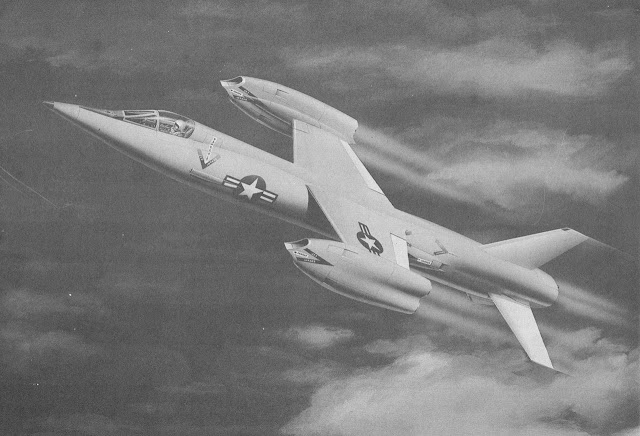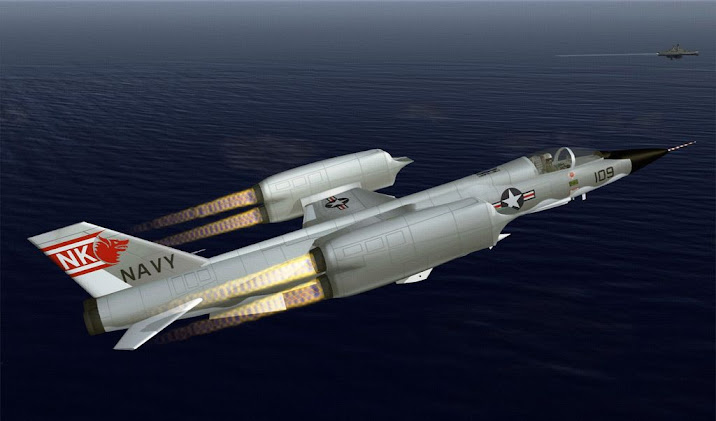Il BELL D-188A (designazioni militari non ufficiali XF-109 / XF3L) era una proposta di un aereo da caccia con otto motori da Mach 2, capace di decollo e atterraggio verticale (VTOL) che non procedette oltre la fase di mock-up.
Sviluppo
Nel 1955, la Bell Aircraft fu invitata dall'USAF e dalla US Navy a sviluppare un caccia bombardiere supersonico e intercettare VTOL / STOVL, ogni tempo. Il progetto era molto ambizioso ed era concepito per soddisfare una moltitudine di ruoli per due diversi servizi. L'aereo fu designato come Modell 2000 e venne proposto in due diverse versioni:
- il D-188 per la Marina
- e il D-188A per l’US Air Force.
La Bell aveva piuttosto ottimisticamente chiamato la versione Navy XF3L-1 e la versione Air Force XF-109, sebbene nessuna di queste designazioni fosse ufficiale. Nel 1959, la Bell collaborò con la Convair per formare un team congiunto di gestione dei sistemi d'arma al fine di promuovere il programma XF-109. Il 5 dicembre 1960, la Bell mostrò pubblicamente il progetto come XF-109, la versione dell'Air Force, poiché la Marina aveva perso interesse l'anno prima; nella primavera del 1961, l'USAF annullò il programma e nessun esemplare fu costruito.
Designazione
Le designazioni militari non erano ufficiali. La designazione XF3L-1 della US NAVY non venne assegnata, ma sarebbe stata la designazione navale del D-188 se l'aereo fosse stato costruito, poiché questo era il serial number successivo della US Navy. La designazione XF-109 dell’US Air Force era stata precedentemente assegnata ad una variante del Convair F-106B proposta, tuttavia, fu successivamente lasciata vuota e la Bell ipotizzava - se il D-188A fosse stato costruito - che questa sarebbe stata assegnata al nuovo caccia. Molte opere di riferimento si riferiscono al D-188A con il suo presunto numero di serie sperimentale, ma in realtà la designazione XF-109 non venne mai assegnata.
Design
Il velivolo era non convenzionale, e consisteva in una lunga e sottile fusoliera munita di una grande pinna con equilibratori in coda. La cabina di pilotaggio monoposto era all'estremità del muso e l'ala di piccole dimensioni era montata in alto sulla fusoliera. Alle estremità di ogni ala c'erano dei POD che contenevano due turboreattori ciascuno. Questi pod erano stati progettati per ruotare attraverso un arco di 100° (da orizzontale a 10° oltre la verticale) per consentire il volo sia orizzontale che verticale. Per decollare verticalmente, i pod alari venivano ruotati per dirigere la spinta del motore verso il basso; mentre, per il volo orizzontale, i pod venivano ruotati di nuovo orizzontalmente. I pod erano in grado di dirigere la spinta leggermente in avanti anche per dirigere le manovre di atterraggio. Oltre ai quattro motori alari, quattro motori erano anche montati in fusoliera: due nella parte posteriore diretti da due condotti di coda separati e due direttamente a poppa dell'abitacolo e posizionati verticalmente per aiutare il volo VTOL, utilizzando due condotti ventrali. Il D-188A presentava un sistema di spurgo del motore per assistere nel sollevamento verticale e nelle manovre. L'aria di spurgo dai compressori del motore della fusoliera sarebbe stata diretta a un paio di propulsori nella prua e altri due nella coda per favorire i movimenti di beccheggio, rollio e imbardata.
L'armamento sarebbe consistito in due cannoni da 20 mm nella fusoliera, un vano interno per le armi e otto punti duri alari per missili e altri ordigni.
Specifiche (D-188A, come progettato)
Caratteristiche generali:
- Equipaggio: 1
- Lunghezza: 62 ft 0 in (18,90 m)
- Apertura alare: 23 piedi 9 pollici (7,24 m)
- Altezza: 12 ft 9 in (3,89 m)
- Superficie alare: 194 piedi quadrati (18,02 m 2 )
- Peso a vuoto: 13.800 lb (660 kg)
- Peso lordo: 23.917 lb (10.849 kg)
- Motopropulsore: 8 turbojet General Electric J85 -GE-5, spinta da 2.600 lbf (12 kN) ciascuno.
Prestazioni:
- Velocità massima: Mach 2.3
- Intervallo: 2.300 mi (3.900 km, 2.000 nmi)
- Gamma di combattimento: 1.350 mi (2.170 km, 1.170 nmi)
- Servizio soffitto: 60.000 piedi (18.000 m)
- Spinta / peso : 0,87.
Armamento:
- Guns: 4 × 20 millimetri (0.79 in) di cannone
- Razzi: razzi da 108 × 2,75 pollici (70 mm)
- Bombe: 4.000 libbre (1.800 kg).
ENGLISH
The Bell D-188A (unofficial military designations XF-109/XF3L) was a proposed eight-engine Mach 2–capable vertical take-off and landing (VTOL) tiltjet fighter that never proceeded past the mock-up stage.
Development
In 1955, Bell Aircraft was requested by both the USAF and the US Navy to develop a VTOL/STOVL supersonic, all-weather fighter-bomber and defence interceptor. The project was highly ambitious and was designed to fulfill a multitude of roles for two different services. The aircraft was designated the Model 2000, and was offered in two different versions – the D-188 for the Navy and the D-188A for the Air Force. Bell had rather optimistically called the Navy version the XF3L-1 and the Air Force version the XF-109, although neither of these designations were official. In 1959, Bell teamed with Convair to form a joint weapon systems management team in order to push the XF-109 program. On 5 December 1960, Bell publicly showed off the design as the XF-109 – the Air Force version, as the Navy had lost interest the year earlier, however in the spring of 1961, the US Air Force canceled the program and no examples were built.
Designation
The military designations were not official and were speculative on the part of Bell. The Navy's XF3L-1 was not assigned, but would have been the D-188's designation had the aircraft been built, as this was the next in the US Navy's number series. The Air Force XF-109 designation had previously been assigned to a proposed Convair F-106B variant, however, had subsequently been left blank and Bell assumed – if the D-188A had been built – that this would have been assigned to the aircraft. Many reference works refer to the D-188A by its assumed experimental series number, but in fact the XF-109 designator was never assigned.
Design
The aircraft was unconventional, and consisted of a long, thin, area ruled fuselage with a large fin and all-moving stabilators in the tail. The single seat cockpit was in the extreme nose and the small-span wing was mounted high on the fuselage. At the ends of each wing were pods that contained two turbojets each. These pods were designed to swivel through an arc of 100° (horizontal to 10° past vertical) to allow for both horizontal and vertical flight. To take off vertically, the pods were rotated to direct the engine's thrust downward, while for horizontal flight the pods were rotated back to the horizontal. The pods were capable of directing thrust slightly forward as well for enhanced landing maneuvers. In addition to the four wing engines, four engines were also mounted in the fuselage – two in the rear directed out of two separate tail ducts, and two directly aft of the cockpit and positioned vertically to aid in VTOL operation, exhausting out of two ventral ducts. The D-188A featured an engine bleed system to assist in vertical lift and maneuvering. Bleed air from the fuselage engine compressors would have been directed to a pair of thrusters in the nose and two more in the tail to aid in pitch, roll and yaw movements.
Armament would have consisted of two 20mm cannon in the fuselage, an internal weapons bay and eight wing hard points for missiles and other ordnance.
Specifications (D-188A, as designed)
General characteristics:
- Crew: 1
- Length: 62 ft 0 in (18.90 m)
- Wingspan: 23 ft 9 in (7.24 m)
- Height: 12 ft 9 in (3.89 m)
- Wing area: 194 sq ft (18.02 m2)
- Empty weight: 13,800 lb (660 kg)
- Gross weight: 23,917 lb (10,849 kg)
- Powerplant: 8 × General Electric J85-GE-5 turbojets, 2,600 lbf (12 kN) thrust each.
Performance:
- Maximum speed: Mach 2.3
- Range: 2,300 mi (3,900 km, 2,000 nmi)
- Combat range: 1,350 mi (2,170 km, 1,170 nmi)
- Service ceiling: 60,000 ft (18,000 m)
- Thrust/weight: 0.87
Armament
:
- Guns: 4 × 20 mm (0.79 in) cannon
- Rockets: 108 × 2.75 in (70 mm) rockets
- Bombs: 4,000 lb (1,800 kg).
(Web, Google, Wikipedia, You Tube)

































Nessun commento:
Posta un commento
Nota. Solo i membri di questo blog possono postare un commento.